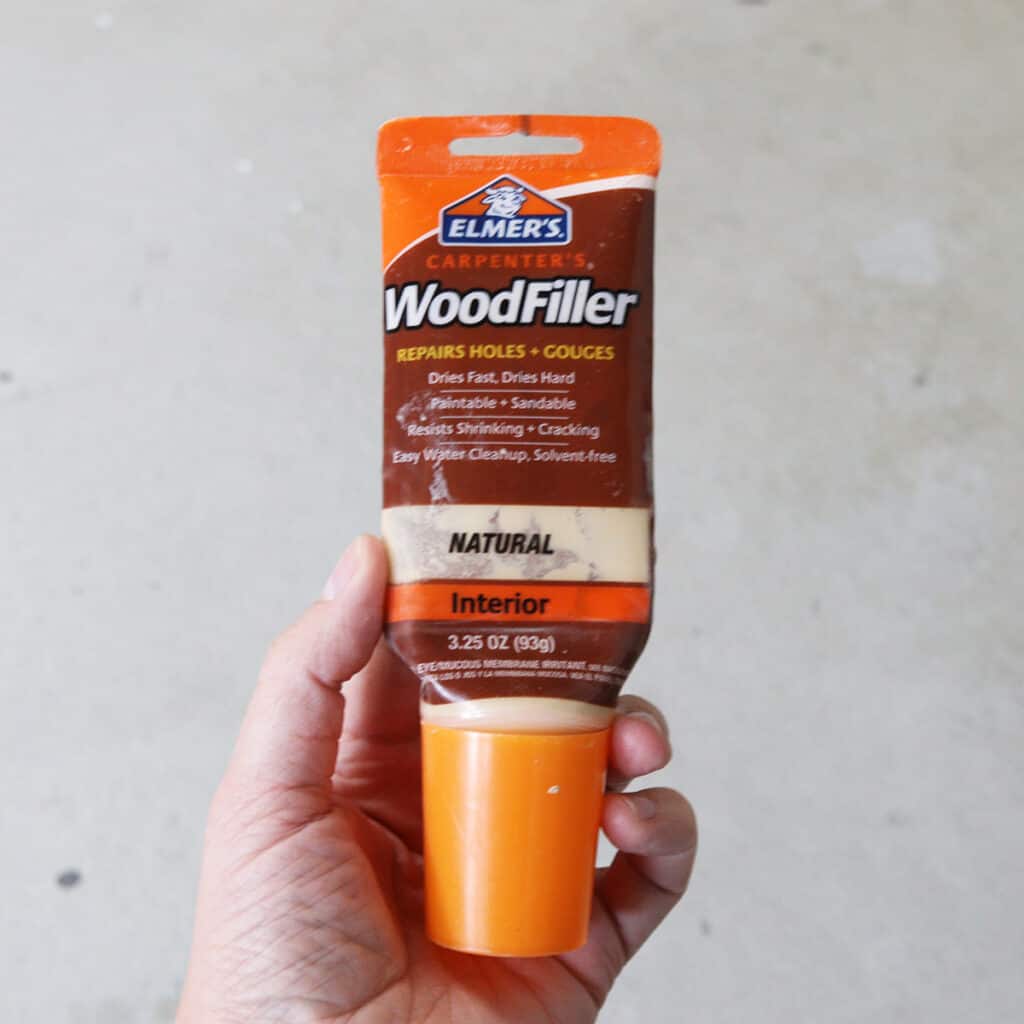Best Wood Fillers for Furniture
Most old furniture has been damaged in some way. So if you’re looking to refinish furniture, you will need to know about the best wood fillers.
Learn more about furniture painting tools and supplies here!

Wood fillers come in handy for all sorts of different situations, from filling in small cracks and holes to repairing larger pieces of damage.
But with so many different types of wood fillers on the market, it can be hard to know which one is right for your project.In this post, we’ll break down the different types of wood fillers and when you should use them.
As an Amazon Associate, I earn from qualifying purchases. I also may earn from other qualifying purchases with other companies or get free product to review and use. All opinions are my own.
Types of Wood Filler
There are two main types of wood filler we use: epoxy-based fillers and latex/water-based fillers.

Epoxy-based fillers, such as Bondo and KwikWood, come in 2 parts, and once those 2 parts are mixed together, they start hardening.
They dry quickly (within an hour), and they dry hard, so they are better for larger repairs. They provide a strong bond and can be sanded down to create a smooth surface.
But, they have more of a smell to them, especially Bondo.
Latex and water-based fillers, such as Elmer’s wood filler and DAP plastic wood filler, are ready to use out of the container.

They aren’t as durable and are better suited for small repairs like filling in holes or cracks that are less than 1/8″ in size.
If you use them on larger repairs, they will shrink a lot or crack. And they will take a very long time to dry.
Best Wood Filler for Veneer Repair
If you have a piece of furniture with a large area or multiple areas of chipped veneer, Bondo is the best wood filler for you!

Bondo is a thinner material that is easy to spread over a large area, making it ideal for repairing veneer. Learn more about repairing veneer with wood filler here.
It also doesn’t shrink and crack like regular wood filler does, and it can easily be sanded smooth.
Here’s everything your need to know about Bondo wood repair for your furniture.
Pros:
- Bondo wood filler can be sanded down once it dries, making it easy to create a smooth surface
- Bondo dries quickly, so you won’t have to wait long before beginning the next step in your project
- It doesn’t shrink and crack like water-based wood fillers do. And it is more durable.
- Can be painted or stained (if you use the wood filler version)
Cons:
- It has a strong smell, so it’s best to use it outside.
- Once mixed up, it starts to harden within minutes, so you have to work fast and know what you are filling.
- Bondo is messy to work with. You have to mix the 2 parts together, and then it is a thinned consistency so it can easily drip.
- You may need to apply multiple coats of Bondo or touch it up with water-based wood filler to get it completely filled.
Here’s my honest and detailed Bondo wood filler review for more information.
The autobody and Multi-Purpose versions work great, too, by the way!
Check out how to repair damaged furniture using Bondo here.
Best Wood Filler for Cabinet Holes
If you need to fill cabinet holes or other deep holes in your furniture, JB Weld KwikWood is the best wood filler for you.

KwikWood comes in a tube and is easy to use without a mess. It dries very hard and doesn’t shrink or crack. Learn more about how to use KwikWood here.
Pros:
- KwikWood dries in an hour or so, so you won’t have to wait long before moving on to the next step in your project.
- It is the consistency of clay, so it can be shaped and molded into the shape you need it to be. And then you don’t have to sand as much after it dries!
- It is durable and will not shrink or crack after it dries, making it a good choice for larger holes or deep cavities.
- There is only a slight smell when using KwikWood.
- Can be painted or stained.
Cons:
- KwikWood can be more expensive than other types of wood fillers.
- It is important to get the right amount and mix completely before applying.
Check out how I fixed a damaged keyhole with Kwikwood in this makeover where I painted furniture with Lilly Moon Paint.
Best Wood Filler for Painting
If you want to fill in small cracks and dings before painting, DAP plastic wood filler is the best wood filler for you.

Plastic Wood is ready to use out of the tube or container, dries quickly, and doesn’t shrink or crack as much as other latex wood fillers, making it ideal for filling small damage when painting projects.
Pros:
- Plastic Wood is easy to apply right out of the container.
- It can be sanded down after it completely dries, making it easy to achieve a smooth surface.
- It doesn’t shrink or crack as much as other latex wood fillers.
- DAP plastic wood filler comes in a variety of colors so you can match it to the color of your wood.
- Very little to no smell.
- Can be painted or stained.
Cons:
- It only dries quickly if used in small areas (less than 1/8″ thick)
- If used on a large area or deep holes, it will take several applications to achieve the desired result.
Best Budget Wood Filler
If you are looking for a good wood filler at a budget-friendly price, Elmer’s Carpenter’s Wood Filler is the best option for you.

Elmer’s Carpenter’s Wood Filler is easy to use and comes in different shades to match your project.
Pros:
- Cheapest option, so it’s great on your wallet.
- Comes in a tube, making it easy to apply and use for small repairs.
- No odor, so it’s easy to use indoors.
- Works well on small cracks, holes, and defects in wood.
Cons:
- Not as durable as other wood fillers, so it doesn’t work as well on larger holes or areas.
- Not the best choice if you want a completely smooth, sanded finish after filling your wood.
- Cracks and shrinks when used on larger repairs.
Best Wood Filler for Corners
If you have a broken or chipped corner on your furniture, JB Weld KwikWood or Bondo wood filler are the best for the job.

You can shape KwikWood to the shape of the corner, and it dries tough, so you don’t have to worry about it easily breaking again.
Bondo is a more cost-effective solution, but it works best if you can make a mold of the shape you need and then mold the Bondo into that shape.
Learn more about how to fix a chipped wood corner with Bondo here.
Get the Secrets!
Grab this super convenient How to Repair Furniture Ebook with all of our secrets on how to repair furniture for only $14.
You can print it out and have instant access whenever you come across damaged furniture, and know exactly how to fix it!
Click on the picture of the book to purchase!
We already covered the pros and cons of each of these above.
Sanding Wood Filler
In order for the wood filler to work its magic, you need to let it dry and then sand it down smoothly. Here are some tips!
How Long Should You Let Wood Filler Dry Before Sanding?
It’s important to let the wood filler dry completely before sanding.
Depending on the type of wood filler you’re using, how big of a repair you filled, and what the weather is like, it can take anywhere from 1-24 hours.
If you try to sand the wood filler while it’s still wet, you’ll just end up making a mess and clogging up your sandpaper.
Water-based wood fillers that are filling damage smaller than 1/8″ should only take an hour or two to dry. But if you try to fill in hardware holes, it can easily take 24 hours for it to dry completely.
Check out this comparison of wood fillers when filling holes when replacing cabinet or furniture hardware to learn more.
On the other hand, if you use an epoxy wood filler, it should take 30 minutes – an hour for it to dry.
Sometimes I feel like Kwikwood takes a couple of hours to be completely dry, though. No matter how big the repair is that we are filling.
What Grit Sandpaper for Wood Filler?
When sanding water-based wood filler, I use medium or fine-grit sandpaper (180 or 220 grit). But, when I have to sand Bondo or Kwikwood, I start with a more coarse grit, like 100 or 120, because it takes longer to sand.
When in doubt, start with a finer grit like 220. If it doesn’t sand away the wood filler very quickly, you can move to a more coarse grit. Learn more about sandpaper for furniture here.
How Much to Sand Wood Filler?
You don’t need to sand off all of the wood filler – just enough so that it’s flush with the surrounding wood surface.
Use gentle, even strokes and avoid applying too much pressure in one spot, which can cause a divot in the area you sand.
Once you’ve finished sanding, wipe away any dust with a clean cloth before proceeding with painting or staining.
How to Make Wood Filler Dry Faster?
You can make water-based wood filler dry faster by applying it in thin layers. Then you can build on the layers as each layer dries.
If you try to speed up the drying time with a hair dryer or let it sit out in the direct sun, the wood filler might crack.
If you need it to dry quickly in a large area, you may consider using Bondo instead. Bondo dries very quickly, even for large repairs.
Is Wood Filler Stainable?
Yes, wood filler is stainable. After it has dried and you have sanded it flush with the wood around it, you can stain it. But beware that the wood filler won’t take the stain the same way the wood around it will.
Check out our blog post about staining wood filler to learn more about the effective techniques for staining wood filler.
The best way to stain wood filler is to stain everything with multiple coats of gel stain or use a stain wood repair kit to stain the wood filler a closer color to the stained wood around it.
More Furniture Makeovers using Wood Fillers
- How to Fix Damaged Wood Furniture Before Painting
- Repurpose a Desk into Nightstands
- Chalk Painting Furniture Black
- Wood Stain Repair
- How To Repair Cracks In Antique Wood Furniture
Follow us on YouTube to get more tips for painting furniture.
Or share your project with us on our Facebook Group and be part of our community. See you there!


Sometimes I see a pink wood filler being painted on with a brush to eliminate a heavy wood grain, what is this called
I think you’re talking about spackling, or some wood filler is a pink color when wet, but brown when dry.